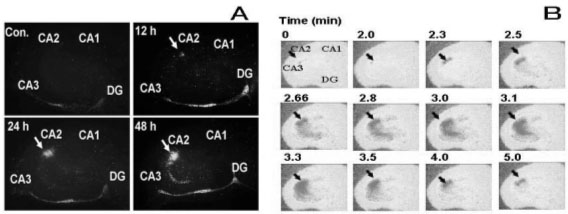Chunxi Han, Nahoko Kasai, and Keiichi Torimitsu
Materials Science Laboratory
Å@Organotypic slice culture technique of rat hippocampus
is very important tool to study the physiological and pharmacological properties
of neuron and neuronal circuits. Because the slices retain the cytoarchitecture
and neuronal circuits of the tissue and because they are relatively easy to
prepare, it is one of the best materials to study long-term studies of neuronal
network. In epileptic animal models and human temporal lobe epilepsy, many
studies have reported that the CA1 and CA3 sectors of the hippocampus are
susceptible to neuronal cell death. However, little attention has been paid
to neuronal cell death in CA2 sector.
Å@In this study, we applied the rat hippocampal slice culture technique to
test whether the CA2 sector is more resistant than other sectors to chronic
stimulation with bicuculline (BiC), a GABAA receptor
antagonist [1][2]. The results indicated that selective neuronal cell death
in the CA2 sector is induced by exposure to BiC for 12 h (Fig. 1A). After
24 h, cell death was observed in an extended area, predominantly in the CA3
sector. We investigated the type of voltage dependent calcium channel (VDCC)
involved in the cell death. It was revealed that the neuronal cell death process
involves a Ca2+ influx (Fig. 1B) via P/Q-type VDCC [1].
[ÇP] C. Han, N. Kasai, K. Torimitsu, Neuroreport 16 (2005)
333-336.
[2] C. Han, N. Kasai, K. Torimitsu, Bul. JSN. 42 (2003) 238.
 |
| Fig. 1. Time- and region-dependent neuronal cell death (A) and Ca2+ influx (B) were induced by exposing the hippocampal slice cultures to BiC. |